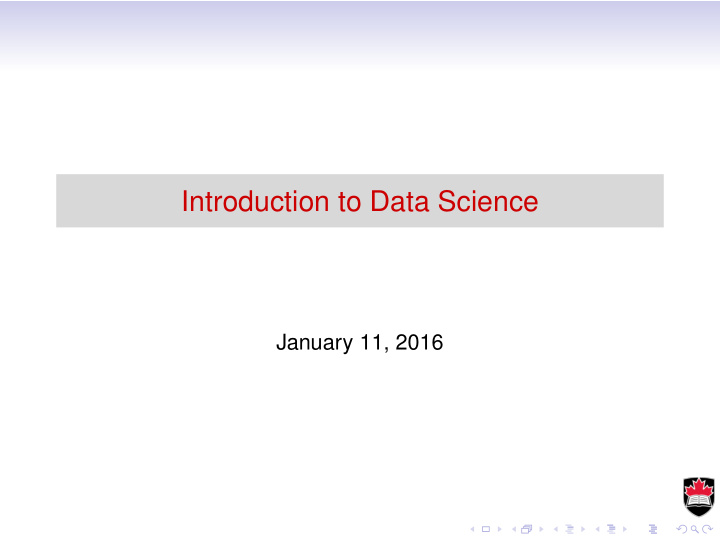



Introduction to Data Science January 11, 2016
About this course DATA 5000: Introduction to Data Science Some highlights: • Topics for data scientists • R • IBM Cognos Workspace, IBM SPSS Modeler, Watson Analytics • VCL cloud • Course projects
Evaluation Course Project • 10% Project proposal, due 25 January, 2016 • 10% Presentation outline, due 17 March, 2016 • 30% Presentation, last two classes 28 March and 4 April, 2016 • 50% Project paper, due April 11, 2016 Details will be discussed later today.
Contact information Olga Baysal Email: olga.baysal@carleton.ca Office hours: By appointment or via Slack Office: HP 5125D Website: http://olgabaysal.com/teaching/winter16/ data5000.html Boyan Bejanov Email: boyanbejanov@cmail.carleton.ca Office hours: By appointment or via Slack Office: none Website: http://scs.carleton.ca/~boyanbejanov/data5000
What is Data Science?
Business efficiency: Wal-Mart http://www.nytimes.com/2004/11/14/business/yourmoney/14wal.html
Business marketing: Target http://tinyurl.com/7jbntx3
Recommendations: Netflix • In October 2006 Netflix held a competition for the best algorithm to predict user ratings of movies. • The winner must improve Netflix’ own algorithm by at least 10% • Award was given in September 2009. http://www2.research.att.com/~volinsky/netflix/bpc.html
Sports analytics
Many others • Cities: http://data.cityofchicago.org/ • Physics: http://particlefever.com/ • Politics: http://53eig.ht/1zPmuCD • Social networks • Biology • Medicine • etc.
Cholera outbreak in London 1856 • Physician John Snow links the outbreak to a contaminated well by plotting number of cases on a map • Started the science of epidemiology
The Winchester Roll of 1086 a.k.a. Domesday Book • Commissioned in 1085 by William the Conqueror • Record of the Great Survey of England • Last used to settle dispute in court in the 1960s! http://www.domesdaybook.co.uk/
Data in the 20-th century What problems were solved? • Engineering: design of machines • Sciences: formulation of theories How were problems solved? • Empirically • Theories • Computation
Data in the 21-st century How is today different? • More data is available • More data is digital • More data is observed, rather than generated by a designed experiment
Data in the 21-st century What problems are solved today? • Spell checking • Face recognition • Sentiment analysis • Optimal routing • High-frequency trading algorithms • just to name a few . . .
Data in the 21-st century How are problems solved today? • Empirically • Theories • Computation • Data exploration http://research.microsoft.com/en-us/collaboration/fourthparadigm/
For example Network security: • 20-th century: based on rules and signatures • 21-st century: data mining traffic logs, cf. http://www.bro.org/ Artificial Intelligence: VS.
A good question So, what is data science?
Who are the data scientists? https://hbr.org/2012/10/data-scientist-the-sexiest-job-of-the-21st-century/ Skills: • make discoveries while swimming in data • don’t allow technical limitations to bog down solutions • often fashion their own tools • skilled in storytelling with data Some data-driven companies: • Google, Wal-Mart, Twitter, LinkedIn, Amazon
What data scientists do • Ask a question • Get relevant data • Prepare data for analysis - outliers, missing values, incorrect values • Explore data - understand the world as it is (was) • Statistical model - estimate/train and validate model - predict what will (likely) happen • Communicate results - tell a story - recommend
Data scientist skills • Computer science - programming, hacking skills • Statistics - probability, distributions, modelling • Mathematics - linear algebra, calculus, optimization • Domain expertise - storytelling, pose question, interpret result • Communication - presentation, data visualization
Drew Conway’s Venn diagram http://drewconway.com/zia/2013/3/26/the-data-science-venn-diagram
Tentative course schedule 11 Jan First class. 25 Jan Project proposals due by end of day. 1 Feb Cognos Workspace, TBC. 15 Feb Reading week, no class 22 Feb SPSS Modeler, TBC. 7 Mar Watson Analytics, TBC. Presentation outlines due by March 17. 14, 21 Mar Guest lectures. 28 Mar Project presentations. 4 Apr Project presentations, last class. 11 Apr Project papers due.
Books Note: These books are not required. Books used for this course: • Doing Data Science by Cathy O’Neil and Rachel Schutt • Data Mining And Business Analytics With R by Johannes Ledolter • Data Science for Business by Foster Provost and Tom Fawcett Other good books: • An Introduction to Statistical Learning by T. Hastie, R. Tibshirani et al. • The Elements of Statistical Learning by T. Hastie, R. Tibshirani et al.
Projects Teams of 2 - no individual projects, no larger groups. No teams with all members from the same department! Email me your team name (optional), and team members by January 17, 2016 (before next class). Project proposals are due January 25, 2016. Proposal should describe your question , the dataset and an idea of what you’ll do with it. Keep it short. Some project ideas and datasets are listed on the course website: http://olgabaysal.com/teaching/winter16/data5000. html#datasets .
Recommend
More recommend